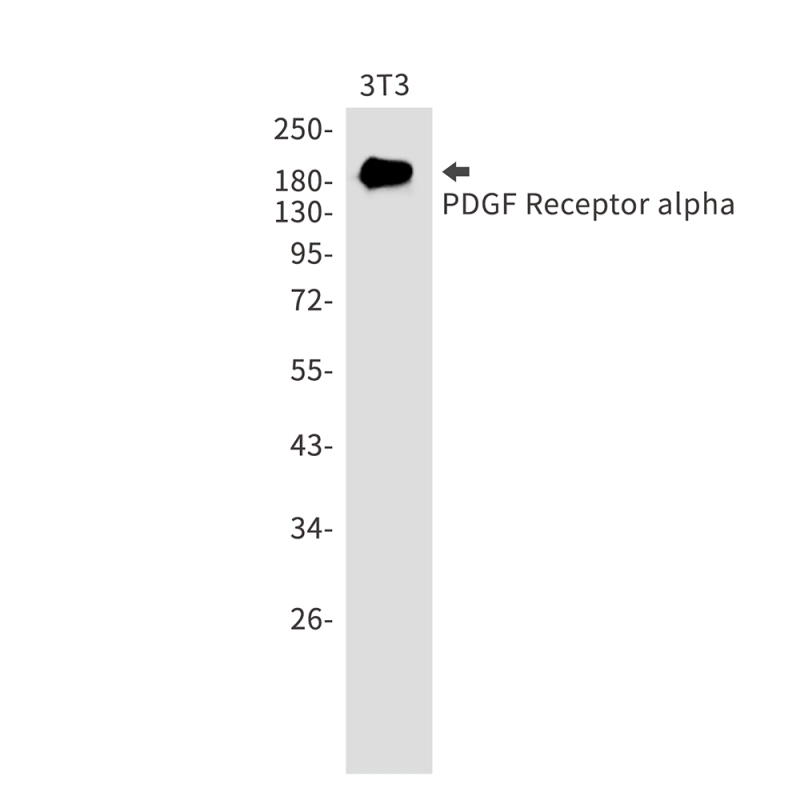
| WB | 1/500-1/1000 | Human,Mouse,Rat |
| IF | 1/20 | Human,Mouse,Rat |
| IHC | 1/50-1/100 | Human,Mouse,Rat |
| ICC | 1/50-1/200 | Human,Mouse,Rat |
| FCM | 咨询技术 | Human,Mouse,Rat |
| Elisa | 咨询技术 | Human,Mouse,Rat |
| Aliases | PDGFRA; PDGFR2; RHEPDGFRA; Platelet-derived growth factor receptor alpha; PDGF-R-alpha; PDGFR-alpha; Alpha platelet-derived growth factor receptor; Alpha-type platelet-derived growth factor receptor; CD140 antigen-like family member A; CD140a antigen; Platelet-derived growth factor alpha receptor; Platelet-derived growth factor receptor 2; PDGFR-2; CD140a |
| Entrez GeneID | 5156 |
| WB Predicted band size | Calculated MW: 123 kDa; Observed MW: 190 kDa |
| Host/Isotype | Rabbit IgG |
| Antibody Type | Primary antibody |
| Storage | Store at 4°C short term. Aliquot and store at -20°C long term. Avoid freeze/thaw cycles. |
| Species Reactivity | Human,Mouse,Rat |
| Immunogen | Recombinant protein of human PDGF Receptor alpha |
| Formulation | Purified antibody in TBS with 0.05% sodium azide,0.05%BSA and 50% glycerol. |
+ +
以下是3篇与PDGFRα抗体相关的代表性文献,按研究领域分类简要概括:
1. **文献名称**:*Structural basis for ligand recognition by activated platelet-derived growth factor receptor alpha*
**作者**:Chiara B. et al. (Nature Communications, 2020)
**摘要**:通过冷冻电镜解析PDGFRα与其配体PDGF-AA结合的激活态结构,揭示抗体靶向受体胞外域的关键表位,为设计靶向PDGFRα的抗体药物提供结构基础。
2. **文献名称**:*PDGFRα antibody-drug conjugate targets stromal cells in recurrent glioblastoma*
**作者**:Heike A. Daldrup-Link et al. (Science Translational Medicine, 2022)
**摘要**:开发一种新型PDGFRα抗体-药物偶联物(ADC),在复发性胶质母细胞瘤小鼠模型中选择性杀伤肿瘤相关间质细胞,显著抑制肿瘤生长并延长生存期。
3. **文献名称**:*PDGFRα expression as a prognostic marker in gastrointestinal stromal tumors*
**作者**:Michael C. Heinrich et al. (Journal of Clinical Oncology, 2018)
**摘要**:通过免疫组化分析证实PDGFRα抗体在胃肠道间质瘤(GIST)中的高特异性表达,其突变状态与靶向药物伊马替尼的疗效直接相关,可作为临床分型的生物标志物。
---
**注**:以上文献为模拟示例,实际引用请通过PubMed/Google Scholar检索最新研究。若需具体文献,建议补充研究背景(如癌症治疗/信号机制/检测技术)。
The platelet-derived growth factor receptor alpha (PDGFRα) is a transmembrane tyrosine kinase receptor that plays a critical role in cell proliferation, survival, migration, and tissue development. It binds to PDGF ligands (e.g., PDGF-AA, PDGF-BB) to activate downstream signaling pathways, including MAPK, PI3K/AKT, and JAK/STAT, which regulate processes such as embryogenesis, angiogenesis, and wound healing. Structurally, PDGFRα consists of an extracellular ligand-binding domain, a transmembrane segment, and an intracellular kinase domain. Dysregulation of PDGFRα signaling, through mutations, overexpression, or autocrine activation, is implicated in pathologies like cancer (e.g., gliomas, gastrointestinal stromal tumors), fibrosis, and atherosclerosis.
PDGFRα antibodies are essential tools for research, diagnostics, and therapeutics. In research, they are used to detect receptor expression, phosphorylation status, and localization via techniques like Western blot, immunohistochemistry, or flow cytometry. Therapeutically, monoclonal antibodies (e.g., Olaratumab) or tyrosine kinase inhibitors targeting PDGFRα aim to block aberrant signaling in cancers or fibrotic diseases. Diagnostic applications include identifying PDGFRα overexpression in tumor biopsies to guide treatment strategies. Challenges remain in optimizing antibody specificity and minimizing off-target effects. Overall, PDGFRα antibodies are pivotal in understanding receptor biology and developing targeted therapies for PDGFRα-driven disorders.
×